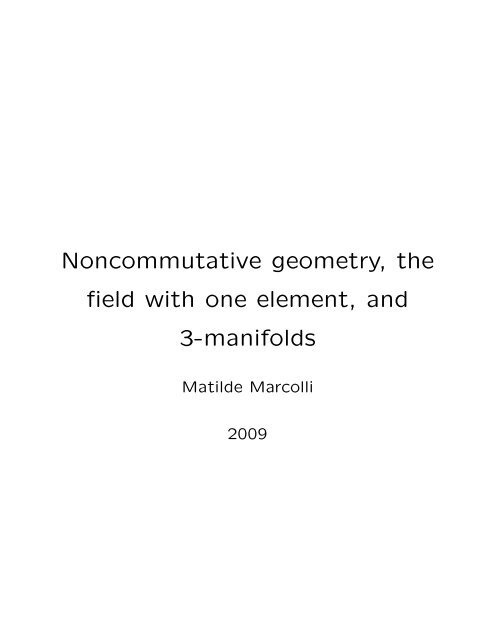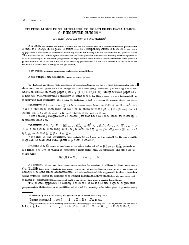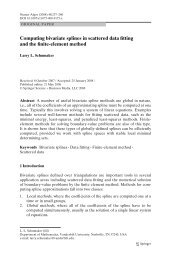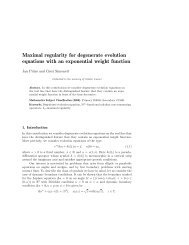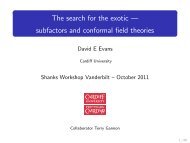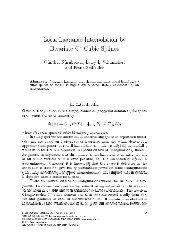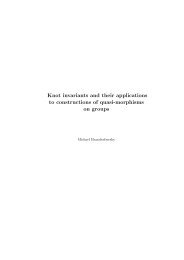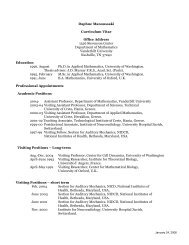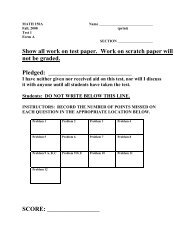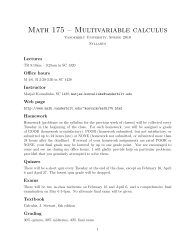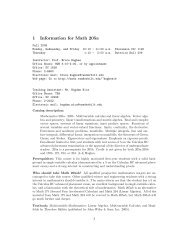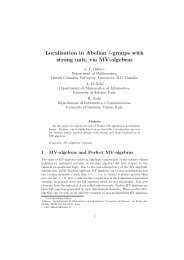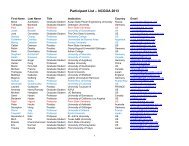Lecture notes of Matilde Marcolli - Vanderbilt University
Lecture notes of Matilde Marcolli - Vanderbilt University
Lecture notes of Matilde Marcolli - Vanderbilt University
Create successful ePaper yourself
Turn your PDF publications into a flip-book with our unique Google optimized e-Paper software.
Noncommutative geometry, the<br />
field with one element, and<br />
3-manifolds<br />
<strong>Matilde</strong> <strong>Marcolli</strong><br />
2009
The field with one element<br />
Finite geometries (q = p k , p prime)<br />
#P n−1 (F q ) = #(An (F q ) {0})<br />
#G m (F q )<br />
= qn − 1<br />
q − 1 = [n] q<br />
#Gr(n, j)(F q ) = #{P j (F q ) ⊂ P n (F q )}<br />
=<br />
[n] q !<br />
[j] q ![n − j] q ! = ( n)<br />
j q<br />
[n] q ! = [n] q [n − 1] q · · ·[1] q , [0] q ! = 1<br />
J. Tits: take q = 1<br />
P n−1 (F 1 ) := finite set <strong>of</strong> cardinality n<br />
Gr(n, j)(F 1 ) := set <strong>of</strong> subsets <strong>of</strong> cardinality j<br />
Algebraic geometry over F 1 ?<br />
1
Extensions F 1 n (Kapranov-Smirnov)<br />
Monoid {0} ∪ µ n (n-th roots <strong>of</strong> unity)<br />
- Vector space over F 1 n: pointed set (V, v) with<br />
free action <strong>of</strong> µ n on V {v}<br />
- Linear maps: permutations compatible with<br />
the action<br />
F 1 n ⊗ F1 Z := Z[t, t −1 ]/(t n − 1)<br />
Zeta functions (Manin) as variety over F 1 :<br />
Z(T n , s) = s − n<br />
2π<br />
with T n = G n m<br />
⇒ F 1 -geometry and infinite primes (Arakelov)<br />
Γ C (s) −1 = ((2π) −s Γ(s)) −1 = ∏ s + n<br />
2π<br />
n≥0<br />
like a “dual” infinite projective space ⊕ ∞ n=0 T−n over F 1<br />
Note: Spec(Z) not a (fin. type) scheme over<br />
F 1 : what is Z ⊗ F1 Z??<br />
More recently: Soulé, Haran, Dourov, Toen–<br />
Vaquie, Connes–Consani, Borger<br />
2
Focus on two approaches:<br />
Descent data for rings from Z to F 1 :<br />
• by cyclotomic points (Soulé)<br />
• by Λ-ring structure (Borger)<br />
Gadgets over F 1<br />
C. Soulé, Les variétés sur le corps à un élément, Mosc.<br />
Math. J. Vol.4 (2004) N.1, 217–244.<br />
(X, A X , e x,σ )<br />
• X : R → Sets covariant functor,<br />
R finitely generated flat rings<br />
• A X complex algebra<br />
• evaluation maps: for all x ∈ X(R), σ : R → C<br />
⇒ e x,σ : A X → C algebra homomorphism<br />
e f(y),σ = e y,σ◦f<br />
for f : R ′ → R ring homomorphism<br />
Affine varieties V Z ⇒ gadget X = G(V Z ) with<br />
X(R) = Hom(O(V ), R) and A X = O(V ) ⊗ C<br />
3
Affine variety over F 1 (Soulé)<br />
Gadget with X(R) finite; variety X Z and morphism<br />
<strong>of</strong> gadgets<br />
X → G(X Z )<br />
such that all X → G(V Z ) come from X Z → V Z<br />
Should think: R = Z[Z/nZ] ⇒ X(R) cyclotomic points<br />
Λ-rings, endomotives, and F 1<br />
J. Borger, Λ-rings and the field with one element, preprint<br />
2009<br />
- Grothendieck: characteristic classes, Riemann–<br />
Roch<br />
- Λ-ring structure: “descent data” for a ring<br />
from Z to F 1<br />
Torsion free R with action <strong>of</strong> semigroup N by<br />
endomorphisms lifting Frobenius<br />
s p (x) − x p ∈ pR,<br />
Morphisms: f ◦ s k = s k ◦ f<br />
∀x ∈ R<br />
Q-algebra A ⇒ Λ-ring<br />
iff action <strong>of</strong> Gal(¯Q/Q) × N on X = Hom(A, ¯Q) factors<br />
through an action <strong>of</strong> Ẑ<br />
4
NCG <strong>of</strong> Q-lattices<br />
Alain Connes, M.M., Quantum statistical mechanics <strong>of</strong><br />
Q-lattices in “Frontiers in number theory, physics, and<br />
geometry. I”, 269–347, Springer, Berlin, 2006.<br />
Definition: (Λ, φ) Q-lattice in R n<br />
lattice Λ ⊂ R n + labels <strong>of</strong> torsion points<br />
φ : Q n /Z n −→ QΛ/Λ<br />
group homomorphism (invertible Q-lat if isom)<br />
φ<br />
general case<br />
invertible case<br />
φ<br />
Commensurability (Λ 1 , φ 1 ) ∼ (Λ 2 , φ 2 )<br />
iff QΛ 1 = QΛ 2 and φ 1 = φ 2 mod Λ 1 + Λ 2<br />
Q-lattices / Commensurability ⇒ NC space<br />
5
1-dimensional case<br />
(Λ, φ) = (λ Z, λ ρ) λ > 0<br />
ρ ∈ Hom(Q/Z, Q/Z) = lim ←−n<br />
Z/nZ = Ẑ<br />
Up to scaling λ: algebra C(Ẑ)<br />
Commensurability Action <strong>of</strong> N = Z >0<br />
α n (f)(ρ) = f(n −1 ρ)<br />
zero otherwise<br />
(partially defined action <strong>of</strong> Q ∗ + )<br />
1-dimensional Q-lattices up to scale / Commens.<br />
⇒ NC space C(Ẑ) ⋊ N<br />
Crossed product algebra<br />
f 1 ∗ f 2 (r, ρ) =<br />
f ∗ (r, ρ) = f(r −1 , rρ)<br />
∑<br />
s∈Q ∗ + ,sρ∈Ẑ<br />
f 1 (rs −1 , sρ)f 2 (s, ρ)<br />
6
Bost–Connes algebra<br />
J.B. Bost, A. Connes, Hecke algebras, type III factors<br />
and phase transitions with spontaneous symmetry<br />
breaking in number theory. Selecta Math. (N.S.) Vol.1<br />
(1995) N.3, 411–457.<br />
Algebra A Q,BC = Q[Q/Z] ⋊ N generators and<br />
relations<br />
µ n µ m = µ nm<br />
µ n µ ∗ m = µ∗ m µ n when (n, m) = 1<br />
µ ∗ nµ n = 1<br />
e(r + s) = e(r)e(s), e(0) = 1<br />
ρ n (e(r)) = µ n e(r)µ ∗ n = 1 n<br />
∑<br />
ns=r<br />
e(s)<br />
C ∗ -algebra C ∗ (Q/Z) ⋊ N = C(Ẑ) ⋊ N<br />
Time evolution<br />
σ t (e(r)) = e(r),<br />
σ t (µ n ) = n it µ n<br />
Hamiltonian Tr(e −βH ) = ζ(β)<br />
7
Quantum statistical mechanics<br />
(A, σ t ) C ∗ -algebra and time evolution<br />
State: ϕ : A → C linear ϕ(1) = 1, ϕ(a ∗ a) ≥ 0<br />
Time evolution σ t ∈ Aut(A)<br />
rep. on Hilbert space H ⇒ Hamiltonian H =<br />
d<br />
dt σ t| t=0<br />
Equilibrium states (inverse temperature β = 1/kT)<br />
1<br />
Z(β) Tr ( a e −βH)<br />
Classical points <strong>of</strong> NC space<br />
Z(β) = Tr ( e −βH)<br />
KMS states ϕ ∈ KMS β (0 < β < ∞)<br />
∀a, b ∈ A ∃ holom function F a,b (z) on strip: ∀t ∈ R<br />
F a,b (t) = ϕ(aσ t (b))<br />
F a,b (t + iβ) = ϕ(σ t (b)a)<br />
8
More on Bost–Connes<br />
• Representations π ρ on l 2 (N):<br />
µ n ǫ m = ǫ nm , π ρ (e(r))ǫ m = ζ m r ǫ m<br />
ζ r = ρ(e(r)) root <strong>of</strong> 1, for ρ ∈ Ẑ ∗<br />
• Low temperature extremal KMS (β > 1)<br />
ϕ β,ρ (a) = Tr(π ρ(a)e −βH )<br />
Tr(e −βH , ρ ∈ Ẑ ∗<br />
)<br />
High temperature: unique KMS state<br />
• Zero temperature: evaluations ϕ ∞,ρ (e(r)) = ζ r<br />
ϕ ∞,ρ (a) = 〈ǫ 1 , π ρ (a)ǫ 1 〉<br />
Intertwining: a ∈ A Q,BC , γ ∈ Ẑ ∗<br />
ϕ ∞,ρ (γa) = θ γ (ϕ ∞,ρ (a))<br />
θ : Ẑ ∗ ≃ → Gal(Q<br />
ab /Q)<br />
Class field theory isomorphism<br />
9
Bost–Connes endomotive<br />
A.Connes, C.Consani, M.M., Noncommutative geometry<br />
and motives: the thermodynamics <strong>of</strong> endomotives,<br />
Adv. in Math. 214 (2) (2007), 761–831<br />
A = lim −→n<br />
A n with A n = Q[Z/nZ]<br />
abelian semigroup action S = N on A = Q[Q/Z]<br />
Endomotives (A, S) from self maps <strong>of</strong> algebraic<br />
varieties s : Y → Y , s(y 0 ) = y 0 unbranched,<br />
X s = s −1 (y 0 ), X = lim ←−<br />
X s = Spec(A)<br />
ξ s,s ′ : X s ′ → X s , ξ s,s ′(y) = r(y), s ′ = rs ∈ S<br />
Bost–Connes endomotive:<br />
G m with self maps u ↦→ u k<br />
s k : P(t, t −1 ) ↦→ P(t k , t −k ), k ∈ N, P ∈ Q[t, t −1 ]<br />
ξ k,l (u(l)) = u(l) k/l , u(l) = t mod t l − 1<br />
X k = Spec(Q[t, t −1 ]/(t k − 1)) = s −1<br />
k<br />
(1) and<br />
X = lim ←−k<br />
X k<br />
u(l) ↦→ e(1/l) ∈ Q[Q/Z],<br />
C(X(¯Q)) = C(Ẑ)<br />
10
Integer model <strong>of</strong> the Bost–Connes algebra<br />
A.Connes, C.Consani, M.M., Fun with F 1 , to appear in<br />
J.Number Theory, arXiv:0806.2401<br />
A Z,BC generated by Z[Q/Z] and µ ∗ n , ˜µ n<br />
˜µ n˜µ m = ˜µ nm<br />
µ ∗ nµ ∗ m = µ ∗ nm<br />
µ ∗ n˜µ n = n<br />
˜µ n µ ∗ m = µ∗ m˜µ n (n, m) = 1.<br />
µ ∗ nx = σ n (x)µ ∗ n and x˜µ n = ˜µ n σ n (x)<br />
where σ n (e(r)) = e(nr) for r ∈ Q/Z<br />
Note: ρ n (x) = µ n xµ ∗ n ring homomorphism but<br />
not ˜ρ n (x) = ˜µ n xµ ∗ n (correspondences “crossed<br />
product” A Z,BC = Z[Q/Z] ⋊˜ρ N)<br />
11
NCG and Soulé’s F 1 -geometry:<br />
Roots <strong>of</strong> unity as varieties over F 1 :<br />
µ (k) (R) = {x ∈ R | x k = 1} = Hom Z (A k , R)<br />
A k = Z[t, t −1 ]/(t k − 1)<br />
• Inductive system G m over F 1 :<br />
µ (n) (R) ⊂ µ (m) (R), n|m, A m ։ A n<br />
A X = C(S 1 )<br />
• Projective system (BC): ξ m,n : X n ։ X m<br />
ξ m,n : µ (n) (R) ։ µ (m) (R),<br />
n|m<br />
µ ∞ (R) = Hom Z (Z[Q/Z], R)<br />
⇒ projective system <strong>of</strong> affine varieties over F 1<br />
ξ m,n : F 1 n ⊗ F1 Z → F 1 m ⊗ F1 Z<br />
A X = C[Q/Z]<br />
12
Bost–Connes and F 1<br />
A.Connes, C.Consani, M.M., Fun with F 1 , arXiv:0806.2401<br />
Affine varieties µ (n) over F 1 defined by gadgets<br />
G(Spec(Q[Z/nZ])); projective system<br />
Endomorphisms σ n (<strong>of</strong> varieties over Z, <strong>of</strong> gadgets,<br />
<strong>of</strong> F 1 -varieties)<br />
Extensions F 1 n: free actions <strong>of</strong> roots <strong>of</strong> 1<br />
(Kapranov–Smirnov)<br />
ζ ↦→ ζ n , n ∈ N<br />
and ζ ↦→ ζ α ↔ e(α(r)), α ∈ Ẑ<br />
Frobenius action on F 1 ∞<br />
In reductions mod p <strong>of</strong> integral Bost–Connes<br />
endomotive ⇒ Frobenius<br />
Bost–Connes = extensions F 1 n plus Frobenius<br />
13
Characteristic p versions <strong>of</strong> the BC endomotive<br />
Q/Z = Q p /Z p × (Q/Z) (p)<br />
denom = power <strong>of</strong> p; denom = prime to p<br />
K[Q p /Z p ] ⋊ p Z+<br />
endomorphisms σ n for n = p l , l ∈ Z +<br />
ϕ Fp (x) = x p Frobenius <strong>of</strong> K char p<br />
f ∈ K[Q/Z]<br />
(σ p l ⊗ ϕ l F p<br />
)(f) = f pl<br />
(σ p l ⊗ϕ l F p<br />
)(e(r)⊗x) = e(p l r)⊗x pl = (e(r)⊗x) pl<br />
⇒ BC endomorphisms restrict to Frobenius on<br />
mod p reductions: σ p l Frobenius correspondence<br />
on pro-variety µ ∞ ⊗ Z K<br />
14
NCG and Borger’s F 1 -geometry<br />
M.M., Cyclotomy and endomotives, preprint arXiv:0901.3167<br />
Multivariable Bost–Connes endomotives<br />
Variety T n = (G m ) n endomorphisms α ∈ M n (Z) +<br />
X α = {t = (t 1 , . . . , t n ) ∈ T n | s α (t) = t 0 }<br />
ξ α,β : X β → X α , t ↦→ t γ , α = βγ ∈ M n (Z) +<br />
t ↦→ t γ = σ γ (t) = (t γ 11<br />
1 tγ 12<br />
2 · · · tγ 1n<br />
n , . . . , tγ n1<br />
1 tγ n2<br />
2 · · · tγ nn<br />
n )<br />
X = lim ←−α<br />
X α with semigroup action<br />
C(X(¯Q)) ∼ = Q[Q/Z] ⊗n generators e(r 1 ) ⊗ · · · ⊗ e(r n )<br />
A n = Q[Q/Z] ⊗n ⋊ ρ M n (Z) +<br />
generated by e(r) and µ α , µ ∗ α<br />
ρ α (e(r)) = µ α e(r)µ ∗ α = 1<br />
det α<br />
∑<br />
α(s)=r<br />
σ α (e(r)) = µ ∗ α e(r)µ α = e(α(r))<br />
Endomorphisms:<br />
σ α (e(r)) = µ ∗ α e(r)µ α<br />
e(s)<br />
15
The Bost–Connes endomotive is a direct limit<br />
<strong>of</strong> Λ-rings<br />
R n = Z[t, t −1 ]/(t n −1) s k (P)(t, t −1 ) = P(t k , t −k )<br />
Action <strong>of</strong> Ẑ:<br />
α ∈ Ẑ : (ζ : x ↦→ ζx) ↦→ (ζ : x ↦→ ζ α x)<br />
Ẑ = Hom(Q/Z, Q/Z)<br />
⇒ Frobenius over F 1 ∞ (Haran)<br />
Embeddings <strong>of</strong> Λ-rings (Borger–de Smit)<br />
Every torsion free finite rank Λ-ring embeds<br />
in Z[Q/Z] ⊗n with action <strong>of</strong> N compatible with<br />
S n,diag ⊂ M n (Z) +<br />
BC systems as universal Λ-rings<br />
⇒ multivariable Bost–Connes endomotives as<br />
universal Λ-rings<br />
16
Quantum statistical mechanics<br />
<strong>of</strong> multivariable Bost–Connes endomotives<br />
Representations on l 2 (M n (Z) + ): ζ α i<br />
= ∏ j ζα ij<br />
i<br />
ζ = (ζ 1 , . . . , ζ n ) = ρ(r),<br />
ρ ∈ GL n (Ẑ)<br />
µ β ǫ α = ǫ βα<br />
π ρ (e(r))ǫ α = ∏ i<br />
ζ ατ<br />
i ǫ α<br />
Time evolution:<br />
σ t (e(r)) = e(r),<br />
σ t (µ α ) = det(α) it µ α<br />
Hamiltonian:<br />
Hǫ α = logdet(α) ǫ α<br />
Problem: Infinite multiplicities in the spectrum:<br />
SL n (Z)-symmetry<br />
17
Groupoid and convolution algebra<br />
Similar to: A.Connes, M.M. Quantum statistical mechanics<br />
<strong>of</strong> Q-lattices, in “Frontiers in Number Theory,<br />
Physics, and Geometry, I” pp.269–350, Springer, 2006.<br />
U Γ = {(α, ρ) ∈ Γ\GL n (Q) + × Γ Ẑ n | α(ρ) ∈ Ẑ n }<br />
Quotient U Γ by SL n (Z) × SL n (Z)<br />
(γ 1 , γ 2 ) : (α, ρ) ↦→ (γ 1 αγ2 −1 , γ 2(ρ))<br />
Convolution algebra<br />
(f 1 ⋆ f 2 )(α, ρ) =<br />
∑<br />
(α,ρ)=(α 1 ,ρ 1 )◦(α 2 ,ρ 2 )∈U Γ<br />
f 1 (α 1 , ρ 1 )f 2 (α 2 , ρ 2 )<br />
f ∗ (α, ρ) = f(α −1 , α(ρ)) and σ t (f)(α, ρ) = det(α) it f(α, ρ)<br />
∑<br />
(π ρ (f)ξ)(α) =<br />
f(αβ −1 , β(ρ))ξ(β)<br />
β∈Γ\GL n (Q) + : βρ∈Ẑ ∗<br />
On l 2 (Γ\G ρ ). If ρ ∈ (Ẑ ∗ ) n :<br />
G ρ = {α ∈ GL n (Q) + | α(ρ) ∈ Ẑ n } = M n (Z) +<br />
Z(β) =<br />
∑<br />
m∈Γ\M n (Z) + det(m) −β 18
Why QSM?<br />
A.Connes, C.Consani, M.M., The Weil pro<strong>of</strong> and the geometry<br />
<strong>of</strong> the adeles class space, arXiv:math/0703392<br />
For original BC system ⇒ dual system<br />
 = A ⋊ σ R. Restriction map:<br />
δ : Â ♮ β → S♮ (Ω β )<br />
Cyclic module: cokernel HC 0 (D(A, ϕ))<br />
⇒ Spectral realization <strong>of</strong> zeros <strong>of</strong> Riemann<br />
zeta function and trace formula<br />
Multivariable case:<br />
Manin (1994): problem <strong>of</strong> Z ⊗ F1 Z =???<br />
cf. Weil’s pro<strong>of</strong> for function fields C × Fq C<br />
Zeta function viewpoint: Kurokawa<br />
tensor product zeta function: summing over zeros<br />
∏<br />
λ∈Ξ(s − λ) m λ<br />
⊗ ∏ µ∈Θ<br />
∏<br />
(s − µ) n µ<br />
:= (s − λ − µ) m λ+n µ<br />
(λ,µ)<br />
as zeta-regularized infinite products<br />
Question: Kurokawa zeta functions from multivariable<br />
dual systems?<br />
19
Thermodynamics <strong>of</strong> endomotives and RH<br />
A.Connes, C.Consani, M.M., Noncommutative geometry<br />
and motives: the thermodynamics <strong>of</strong> endomotives,<br />
Adv. in Math. 214 (2) (2007), 761–831<br />
• Dual system: Â = A BC ⋊ σ R<br />
• Scaling action: θ λ ( ∫ x(t) U t dt) = ∫ λ it x(t) U t dt<br />
• Classical points: ˜Ω β ≃ Ω β × R ∗ +<br />
• Restriction map: (morphism <strong>of</strong> cyclic modules)<br />
δ : Â β<br />
low T KMS states<br />
π<br />
−→ C(˜Ω β , L 1 ) −→ Tr C(˜Ω β )<br />
• Cokernel (abelian category) D(A, ϕ) = Coker(δ)<br />
• Cyclic homology (with scaling action) HC 0 (D(A, ϕ))<br />
• Galois action+ scaling C Q = Ẑ ∗ × R ∗ +<br />
Weil explicit formula as trace formula<br />
on H 1 = HC 0 (D(A, ϕ)):<br />
Tr(ϑ(f)| H 1) = ˆf(0)+ˆf(1)−∆•∆f(1)− ∑ v<br />
ϑ(f) =<br />
∫<br />
∫ ′<br />
C Q<br />
f(g)ϑ g d ∗ g f ∈ S(C Q )<br />
(K ∗ v,e Kv )<br />
Self inters <strong>of</strong> diagonal ∆ • ∆ = log |a| = −log |D|<br />
f(u −1 )<br />
|1 − u| d∗ u<br />
(D = discriminant for #-field, Euler char χ(C) for F q (C))<br />
20
Note:<br />
• Connes’ 1997 RH paper: Tr(R Λ U(f)):<br />
- only critical line zeros<br />
- Trace formula (global) ⇔ RH<br />
• Tr(ϑ(f)| H 1):<br />
- all zeros involved<br />
- RH ⇔ positivity<br />
Tr ( ϑ(f ⋆ f ♯ )| H 1)<br />
≥ 0 ∀f ∈ S(CQ )<br />
where<br />
(f 1 ⋆ f 2 )(g) =<br />
∫<br />
f 1 (k)f 2 (k −1 g)d ∗ g<br />
multiplicative Haar measure d ∗ g and adjoint<br />
f ♯ (g) = |g| −1 f(g −1 )<br />
⇒ Better for comparing with Weil’s pro<strong>of</strong> for<br />
function fields<br />
21
Weil’s pro<strong>of</strong> in a nutshell<br />
K = F q (C) function field, Σ K = places deg n v = # orbit<br />
<strong>of</strong> Fr on fiber C(¯F q ) → Σ K<br />
ζ K (s) = ∏ Σ K<br />
(1 − q −n vs ) −1 =<br />
P(q −s )<br />
(1 − q −s )(1 − q 1−s )<br />
P(T) = ∏ (1−λ n T) char polynomial <strong>of</strong> Fr ∗ on H 1 et (¯C, Q l )<br />
C(¯F q ) ⊃ Fix(Fr j ) = ∑ k<br />
(−1) k Tr(Fr ∗j |H k et(¯C, Q l ))<br />
RH ⇔ eigenvalues λ n with |λ j | = q 1/2<br />
Correspondences: divisors Z ⊂ C × C; degree, codegree,<br />
trace:<br />
d(Z) = Z • (P × C) d ′ (Z) = Z • (C × P)<br />
Tr(Z) = d(Z) + d ′ (Z) − Z • ∆<br />
RH ⇔ Weil positivity Tr(Z ⋆ Z ′ ) > 0<br />
⇒ Dictionary between NCG and Alg Geom:<br />
C × Fq C ⇔ NCG version <strong>of</strong> Spec(Z)× F1 Spec(Z)<br />
22
A possible intermediate step: Witt vectors<br />
Affine ring scheme <strong>of</strong> big Witt vectors<br />
Z[λ 1 , λ 2 , . . . , λ n , . . .]<br />
symmetric functions λ i , ghost coordinates<br />
ψ n = ∑ d|n<br />
d u n/d<br />
d<br />
, with ψ n = x n 1 + xn 2 + · · ·<br />
W(R) = ∏ n≥1 R addition/multipl <strong>of</strong> ghost coords<br />
Truncated Witt schemes with Z[u 1 , . . . , u N ] ⇒<br />
gadgets W (N)<br />
Z<br />
over F 1 (Manin)<br />
Also Λ-ring structure given by the ψ n<br />
Borger’s suggestion: Witt schemes related to<br />
Spec(Z) × F1 · · · × F1 Spec(Z)<br />
⇒ Realize inside multivariable BC endomotives<br />
23
Other aspects <strong>of</strong> F 1 -geometry:<br />
Analytic geometry<br />
Yu.I. Manin, Cyclotomy and analytic geometry over F 1 ,<br />
arXiv:0809.1564.<br />
The Habiro ring<br />
K. Habiro, Cyclotomic completions <strong>of</strong> polynomial rings,<br />
Publ. RIMS Kyoto Univ. (2004) Vol.40, 1127–1146.<br />
Ẑ[q] = lim ←−n<br />
Z[q]/((q) n )<br />
(q) n = (1 − q)(1 − q 2 ) · · ·(1 − q n )<br />
Z[q]/((q) n ) ։ Z[q]/((q) k ) for k ≤ n since (q) k |(q) n<br />
Evaluation maps at roots <strong>of</strong> 1: surj ring homom<br />
ev ζ :<br />
Ẑ[q] → Z[ζ]<br />
give an injective homomorphism:<br />
ev : Ẑ[q] → ∏<br />
Z[ζ]<br />
Taylor series expansions<br />
ζ∈Z<br />
τ ζ :<br />
Ẑ[q] → Z[ζ][[q − ζ]]<br />
injective ring homomorphism<br />
24
Ring <strong>of</strong> “analytic functions on roots <strong>of</strong> unity”<br />
⇒ Another model for the NCG <strong>of</strong> the cyclotomic<br />
tower, replacing Q[Q/Z] with Ẑ[q]<br />
Multivariable Habiro rings (Manin)<br />
̂ Z[q 1 , . . . , q n ] = lim ←−N<br />
Z[q 1 , . . . , q n ]/I n,N<br />
where I n,N is the ideal<br />
( (q1 − 1)(q 2 1 − 1) · · ·(qN 1 − 1), . . . ,(q n − 1)(q 2 n − 1) · · ·(qN n − 1))<br />
Evaluations at roots <strong>of</strong> 1<br />
ev (ζ1 ,...,ζ n ) :<br />
Taylor expansions<br />
T Z :<br />
̂ Z[q1 , . . . , q n ] → Z[ζ 1 , . . . , ζ n ]<br />
̂ Z[q1 , . . . , q n ] → Z[ζ 1 , . . . , ζ n ][[q 1 −ζ 1 , . . . , q n −ζ n ]]<br />
Z = (ζ 1 , . . . , ζ n ) in Z n 25
Endomotives: Habiro ring version<br />
M.M., Cyclotomy and endomotives, preprint arXiv:0901.3167<br />
One variable:<br />
σ n (f)(q) = f(q n )<br />
lifts P(ζ) ↦→ P(ζ n ) in Z[ζ] through ev ζ<br />
Action <strong>of</strong> N ⇒ group crossed product<br />
A Z,q = Ẑ[q] ∞ ⋊ Q ∗ +<br />
A Z,q = generated by Ẑ[q] and µ n, µ ∗ n<br />
µ n σ n (f) = fµ n , µ ∗ nf = σ n (f)µ ∗ n<br />
Ẑ[q] ∞ = ∪ N A N with A N gen by µ N fµ ∗ N<br />
Ẑ[q] ∞ = lim −→n<br />
(σ n :<br />
Ẑ[q] → Ẑ[q])<br />
injective ⇒ automorphisms σ n : Ẑ[q] ∞ → Ẑ[q] ∞<br />
26
P Z = polyn in Q powers q r<br />
ˆP Z = lim ←−N<br />
P Z /J N<br />
J N = ideal gen by (q r ) N = (1 − q r ) · · ·(1 − q rN ), r ∈ Q ∗ +<br />
ρ r (f)(q) = f(q r )<br />
Multivariable:<br />
Ẑ[q] ∞ ≃ ˆP Z , µ n fµ ∗ n ↦→ f(q 1/n )<br />
̂ Z[q 1 , . . . , q n ] = lim ←−N<br />
Z[q 1 , . . . , q n , q −1<br />
1 , . . . , q−1 n ]/J n,N<br />
J n,N ideal generated by the (q i − 1) · · ·(q N i<br />
− 1), for i =<br />
1, . . . , n and the (q −1<br />
i<br />
− 1) · · ·(q −N<br />
i<br />
− 1)<br />
Torus T n = (G m ) n , algebra Q[t i , t −1<br />
i<br />
]<br />
t α = (t α i ) i=1,...,n with t α i = ∏ j<br />
t α ij<br />
j<br />
Semigroup action α ∈ M n (Z) + :<br />
q ↦→ σ α (q) = σ α (q 1 , . . . , q n ) =<br />
(q α 11<br />
1 qα 12<br />
2 · · · qα 1n<br />
n , . . . , qα n1<br />
1 qα n2<br />
2 · · · qα nn<br />
n ) = qα 27
Question: 3-manifolds and F 1 -geometry?<br />
Universal Witten–Reshetikhin–Turaev invariant<br />
K.Habiro, A unified Witten–Reshetikhin–Turaev invariant<br />
for integral homology spheres, Invent. Math. 171<br />
(2008) 1–81<br />
- Chern–Simons path integral (Witten)<br />
- quantum groups at roots <strong>of</strong> 1 (Reshetikhin–Turaev)<br />
- Ohtsuki series<br />
τ(M) : Z → C,<br />
τ O (M) = 1 +<br />
τ ζ (M)<br />
∞∑<br />
λ n (M)(q − 1) n<br />
n=1<br />
Unified view (Habiro): J M (q) = J L (q)<br />
J M (q) ∈ Ẑ[q]<br />
function in the (one-variable) Habiro ring:<br />
ev ζ (J M (q)) = τ ζ (M)<br />
τ 1 (J M (q)) = τ O (M)<br />
Using: 3-dimensional integral homology sphere M<br />
surgery presentation M = SL 3 , algebraically split link<br />
L = L 1 ∪ · · · ∪ L l in S 3 framing ±1<br />
SL 3 = ∼ SL 3 ⇔ L ∼ ′ L′ Fenn–Rourke moves<br />
28
Integral homology 3-spheres<br />
Zhs = free ab group generated by orientationpreserving<br />
homeomorphism classes <strong>of</strong> integral<br />
homology 3-spheres<br />
Ring with product M 1 #M 2 connected sum<br />
J M1 #M 2<br />
(q) = J M1 (q)J M2 (q), J S 3(q) = 1<br />
J −M (q) = J M (q −1 )<br />
⇒ WRT ring homomorphism<br />
Ohtsuki filtration<br />
J : Zhs → Ẑ[q]<br />
Zhs = F 0 ⊃ F 1 ⊃ · · · F k ⊃ · · ·<br />
F k Z-submodule spanned by<br />
[M, L 1 , . . . , L k ] =<br />
∑<br />
L ′ ⊂{L 1 ,...,L k }<br />
L i = alg split links ±1-framed<br />
Habiro conjecture<br />
J :<br />
Ẑhs → Ẑ[q]<br />
(−1) |L′ | ML ′<br />
Ẑhs = lim ←−d<br />
Zhs/F d with d : N → Z ≥0<br />
d(n)-components <strong>of</strong> link have framing ±n<br />
29
Integral homology spheres and F 1 ?<br />
X Zhs (R) := {φ : Zhs → R | ∃˜φ : Ẑ[q] → R, φ = ˜φ◦J}<br />
J : Zhs → Ẑ[q] WRT invariant;<br />
X Zhs (R) = set <strong>of</strong> “coarser” R-valued invariants<br />
A X := Zhs⊗C WRT evaluations as cyclotomic<br />
points: σ ◦ φ : Zhs → C factors through some<br />
evaluation ev ζ<br />
⇒ X Zhs gadget over F 1<br />
Question: Using Habiro conjecture XẐhs inductive<br />
limit <strong>of</strong> affine varieties over F 1 ? (finiteness)<br />
30
Question: 3-manifolds and endomotives?<br />
Semigroup action? Is it possible to construct<br />
M = S(L,m) 3 ↦→ σ n(M) = S(L 3 n ,m n )<br />
(inv. under Fenn–Rourke moves)<br />
σ n (M 1 #M 2 ) = σ n (M 1 )σ n (M 2 )<br />
Question: ∃ ? Υ M ∈ Ẑ[q]<br />
Υ σn (M) = σ n(Υ M )<br />
Is it possible to use endomotives (eg multivariable<br />
BC) to construct 3-manifold invariants ?<br />
Zhs ⋊ N → A = A ⋊ N<br />
Quantum statistical mechanics?<br />
31
Categorical approach:<br />
- Reidemeister moves<br />
(link diagrams: same ambient isotopy class)<br />
- Hoste moves (admissible links)<br />
(same Zhs: trivial linking #s and frames 1/m)<br />
component 1/m-framing replaced by −m full<br />
twists<br />
1/m<br />
−m full twists<br />
32
2-category:<br />
- Objects: (D, r) admissible framed link diagrams<br />
- 1-morphisms: (D, r) H → (D ′ , r ′ ) Hoste moves<br />
- 2-morphisms: R = (R, R ′ ) Reidemeister moves<br />
(D 1 , r 1 ) H 1 <br />
(D<br />
1 ′ , r′ 1 )<br />
R<br />
R ′<br />
(D 2 , r 2 ) H 2 <br />
(D ′ 2 , r′ 2 )<br />
Convolution algebra: A CL (2) functions with finite<br />
support on 2-Mor<br />
- vertical convolution product<br />
(f 1 ◦ f 2 )(R) = ∑<br />
R=R 1 ◦R 2<br />
f 1 (R 1 )f 2 (R 2 )<br />
- horizontal convolution product<br />
(f 1 • f 2 )(R) = ∑<br />
R=R 1 •R 2<br />
f 1 (R 1 )f 2 (R 2 )<br />
33
For compositions <strong>of</strong> 2-morphisms:<br />
- horizontal R 1 • R 2 with R 1 = (R, R ′ ) and R 2 = (R ′ , R ′′ )<br />
(D 1 , r 1 ) H 1 <br />
(D<br />
1 ′ , r′ 1 )<br />
R<br />
R ′<br />
H ′ 1 <br />
(D ′′<br />
1 , r′′ 1 )<br />
R ′′<br />
(D 2 , r 2 ) H 2 <br />
(D<br />
2 ′ , r′ 2 ) H′ 2 <br />
(D<br />
2 ′′,<br />
r′′ 2 )<br />
- vertical R 1 ◦ R 2 with R 1 = (R 1 , R ′ 1 ) and R 2 = (R 2 , R ′ 2 )<br />
(D 1 , r 1 ) H 1 <br />
(D<br />
1 ′ , r′ 1 )<br />
R 1<br />
R ′ 1<br />
(D 2 , r 2 ) H 2 <br />
(D 2 ′ , r′ 2 )<br />
R 2<br />
R ′ 2<br />
(D 3 , r 3 ) H 3 <br />
(D ′ 3 , r′ 3 ) 34
Involution: f ∗ (R) = f(R −1 )<br />
(D ′ 2 , r′ 2 ) H −1<br />
2 <br />
R ′−1<br />
(D 2 , r 2 )<br />
R −1<br />
(D<br />
1 ′ , r′ 1 ) H −1<br />
1<br />
(D 1 , r 1 )<br />
- Horizontal time evolution: σ f (f 1 ◦ f 2 ) = σ t (f 1 ) ◦<br />
σ t (f 2 )<br />
σ t (f)(H) = e imt f(H), with m = l − l ′<br />
Hoste move between L = L 1 ∪· · ·∪L l and L ′ = L ′ 1 ∪· · ·∪L′ l ′<br />
- Vertical time evolution: σ f (f 1 •f 2 ) = σ t (f 1 )•σ t (f 2 )<br />
self-linking number with respect to the blackboard<br />
framing <strong>of</strong> the link diagram<br />
(changed by Reidemeister moves)<br />
35
Variant: only oriented Hoste moves (semigroupoid)<br />
Cabling: L n = c n (L) with n = (n, . . . , n)<br />
(L, r) admissible and n|m i : if oriented Hoste<br />
move<br />
(L, r) H → (L ′ , r ′ )<br />
then n|m i also for L ′ and cabled oriented Hoste<br />
move<br />
(L n , nr) H n<br />
→ (L ′ n , nr′ )<br />
Action:<br />
ρ n (f)(H) =<br />
{<br />
f(Hn ) n|m i , ∀i,<br />
0 otherwise,<br />
endomorphisms <strong>of</strong> A CL (1)<br />
(after collapsing 2-morphisms to equiv rel)<br />
36
Similar to case <strong>of</strong><br />
M.M., A.Zainy al-Yasry, Coverings, correspondences, and<br />
noncommutative geometry, J.Geom.Phys. Vol.58 (2008)<br />
N.12, 1639–1661<br />
2-category with Obj=embedded graphs,<br />
1-Mor=3-manifolds as branched coverings,<br />
2-Mor=4-dim cobordisms<br />
Horizontal and vertical time evolutions<br />
(multiplicity <strong>of</strong> coverings, index theorems, Hartle–Hawking<br />
gravity)<br />
Further questions: Relation <strong>of</strong> the Habiro<br />
rings and (semi)group actions to Zagier’s quantum<br />
modular forms ?<br />
37


